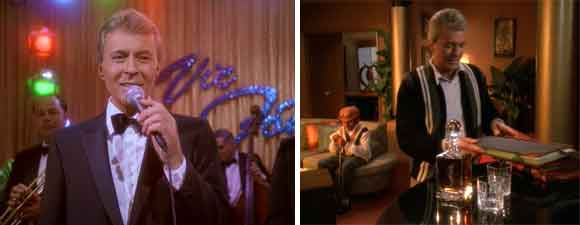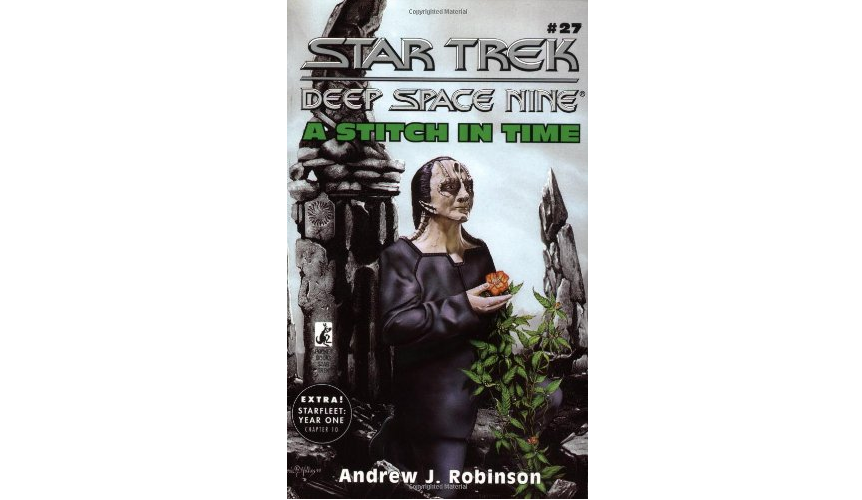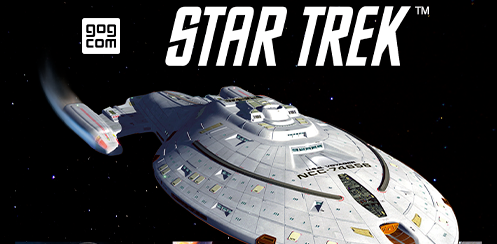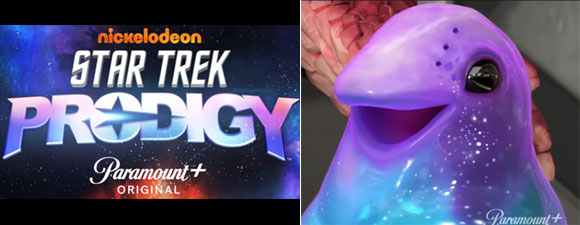Retro Review: The Siege of AR-558
7 min readSisko and several crewmembers choose to remain on an embattled outpost during a grisly battle with the Dominion.
Plot Summary: Sisko leaves on a mission to deliver supplies and medical aid aboard the Defiant with Worf, Dax, and Bashir, along with Quark, who has been sent by the Nagus on a fact-finding mission about the war. When the senior crewmembers beam down to the barren surface of the planet AR-558, they find a group of decimated, demoralized Starfleet officers in the midst of a months-long standoff with Jem’Hadar troops trying to recapture a Dominion communications array that the Federation desperately wants to use to decode Dominion Dominion transmissions. Bashir treats the wounded and warns Sisko that both the physical and mental health of the soldiers is precarious. Lieutenant Larkin, forced to take command when her captain and commander were killed, explains that invisible subspace mines they call Houdinis have shattered her crew. When the Jem’Hadar attack, Sisko orders Worf to take the Defiant to safety so that the DS9 crew on the ground can fight. After the Jem’Hadar send holographic soldiers to assess Starfleet’s strength, Sisko sends Nog on a surveillance mission with Larkin and sends Dax to work with the engineer Kellin on disarming the Houdinis. Nog’s exceptional hearing allows him to find the Jem’Hadar camp, but the Jem’Hadar discovers the scouting party, killing Larkin, injuring Nog. Once Ezri and Kellin make the Houdinis visible, Sisko asks them to devise a plan to use them as weapons against the Jem’Hadar. Bashir is forced to amputate Nog’s leg, enraging Quark and making the younger Ferengi wonder whether the communications array is worth it. The Houdinis cut down many Jem’Hadar, but others wound Bashir and Sisko, who returns to consciousness to find Dax holding the body of Kellin, who died protecting her. The Starfleet officers have triumphed, yet Sisko refuses to leave aboard the Defiant until new troops arrive. Worf calls the battle a great victory, but Sisko, who can name all the casualties, says only, “It cost enough.”
Analysis: Like many of Deep Space Nine‘s best episodes, “The Siege of AR-558” is controversial among original Star Trek fans who find the focus on the horrors of war and the horrifying behavior of humans in such situations to be in opposition to the optimistic, peace-affirming view that Gene Roddenberry espoused. Though the most bitter perspective is voiced by Quark – who’s never been an objective observer of humanity, and who’s always insisted that a compromise-riddled treaty would be more profitable than a war – it’s hard to argue with the Ferengi assessment that while humans may be friendly as long as their bellies are full, they can become as violent as bloodthirsty Klingons when faced with the privations and brutality of combat. Another non-human, Dax, becomes the person to speak up when Sisko decides to use a weapon considered too awful for Starfleet to have developed against Jem’Hadar soldiers. Meanwhile Bashir laments that although he joined Starfleet to save lives, he can use a phaser rifle as well as a combat specialist, and Sisko, who appears to have heeded the lessons of “In the Pale Moonlight” – another controversial episode which rationalizes assassinating a few pawns in the hope of saving many more lives – insists that they will stay alive and protect the communications array no matter the cost. Directed by Vietnam War veteran Winrich Kolbe, the visuals are unflinching and unusually bloody for Star Trek in portraying the pain and misery of the fight for a planet that looks like a forbidding hunk of rock. As a viewer, it’s easy to hate the war and forget the bigger picture, just as these Starfleet officers seem to have done: that without this conflict, without breaking the Dominion’s soldiers and its communication codes, most of the inhabitants of the Alpha Quadrant could lose their freedom. It’s left to viewers to wonder, like Nog, whether this particular battle is really worth it.
I can’t decide whether strengthens or weakens “The Siege of AR-558” to have borrowed from so many movies and television shows about contemporary warfare. Do images and character types taken not primarily from the Battle of Guadalcanal (on which the story is loosely based) but from Apocalypse Now, The Guns of Navarone, and a number of other award-winning pop culture reference points reinforce the horrors of war for viewers? Or do they turn them into what seem more like required storytelling tropes than reality? Particularly when the Cardassians are out of the equation, the conflict between the Dominion and the Federation is easy to see as a black-and-white struggle by valiant if fallible heroes against an implacable enemy. Even when the war looks like hell, the idea of negotiating a truce brings to mind 1938 in Munich, an event mythologized in much of the western world as a symbol of placating evil. Many of us learned more about the Korean War from M*A*S*H than we ever learned in school; I’m in my 40s and was too young to understand the Vietnam War while it was happening, so I assume that viewers younger than myself probably identify even less with the people who fought it. As for the more recent wars fought all over this planet, we’re increasingly aware of how not just governments but vast media empires with financial and political stakes in the conflicts bias our perception of when armed conflict is being used to try to protect a larger peace versus when the greater good is being cited as an excuse to grab land, resources and power. Because the Dominion has such absolute control of its genetically engineered soldiers and strategists, no such propaganda is required in this fictional scenario, but it would have been so interesting to see an episode showing us the Dominion War from the perspective of inhabitants of one of the Dominion’s member worlds, locked in an alliance not wholly of its inhabitants’ choosing, yet being presented with the Federation as a foe so ruthless that no rebellion from within seems to have been considered, though surely planets in the Gamma Quadrant were chafing as much as Betazed to be rid of the Dominion.
Given that the Federation requires the full commitment of so many disparate elements to fight the Dominion, it’s interesting who Sisko does and does not bring to this battle. Not Odo, whose very existence demonstrates that biology is not destiny for everyone created by the Founders; not Kira, whose childhood fighting the Cardassians made her a focused and fearless fighter; not Worf, trained as a warrior from two cultures. Instead he has Bashir, trained to heal; Nog, who’s still a novice; Quark, who hates the whole bloody thing; and Dax, who’s still figuring out who to be this time around. I love when we get to see Ezri realize that she can do things she never imagined because of the symbiont, but it’s a little odd that her internal conflict seems to be between counselor and engineer, not counselor and warrior; I realize that she’s no longer Jadzia, but Sisko was accustomed to asking her the questions he’d once have asked Curzon and this is a situation where I’d think a Dax’s input might be welcomed, even if it’s just for comfort. We really get to see how isolating command is for him, though, beginning and ending with reading casualty lists, beginning and ending with a quarrel with Worf first over whether he should stay for the battle then over whether victory constitutes glory. He’s challenged twice by outsiders – the foot soldiers who’ve been defending AR-558 and Quark, each of whom doubts he can really understand what it’s like to be in the line of fire – Quark spitting that Sisko wouldn’t have sent Jake out, which leads to the nuanced, complicated ambivalence of Sisko’s reply that Jake is not a Starfleet officer. Really, though, despite the shock of Nog’s wounding, a storyline that won’t disappear next week, the most memorable moments come from non-regulars: Larkin, who’s one of the toughest women we ever see in the franchise, Reese, unrecognizable to himself after months of war, and Vargas, who has a devastating monologue describing the death in battle of a man he hadn’t been able to stand in life. Vic Fontaine has what looks like a throwaway comic moment with Rom at the start, yet his character sings a version of “I’ll Be Seeing You” that ends up working as the Jem’Hadar attack like Good Morning Vietnam‘s battle montage to “What a Wonderful World.” There’s a possible outside reference that’s note-perfect.







If the Incredible She-Hulk suddenly showed up and broke through the corridor wall into the Wardroom, Michelle would praise the episode for showing us “one of the toughest women we ever see in the franchise”.
Of course I kid. This is one of the best episodes of the series.
I really don’t think that is very nice, sorry.
Imitation, however, is very nice. I’m flattered, Mr. Troll!
In my opinion, one of the most damaging episodes to Star Trek, ever. DS9’s final two seasons proved that Roddenberry’s utopian future of humanity is less desired by fans than one in which we remain entrenched in endless brutal war.
The She-Hulk? No, the most badass fictional woman warrior is Lagertha/Visenya Targaryen.
https://www.youtube.com/watch?v=-WU9Ioh4zPM
I did not like this episode at all.
Precisely the reason why the first two seasons of TNG are remembered with such fondness?
My pleasure, hope you’re ok bud 🙂
Loved this episode. One of Trek’s best
Star Trek: Deep Space Nine – Call of Duty Edition
Definitely agree. The reviewer is overly critical as to whom Sisko had accompany him on the planet, but I actually thought it was long overdue for the blueshirts to get their share of the action. We get to see Bashir be more than just a doctor and Ezri gets to rely on her skills from her previous hosts with a more scientific background instead of being more of a Klingon wannabe like Jadzia was. Even Quark gets to contribute as he teaches Nog that humans aren’t entirely altruistic and even gets his shots against the Jem’Hadar. This one episode was far better than TNG’s first 2 seasons and Voyager’s entire run overall.
I hate this episode so much.
You do realize that your statements are only an opinion and are not shared by everyone right? I know some Trek fans who think Voyager’s worst episode (Threshold) is better than DS9s best episode. I don’t go quite that far myself but for me Voyager, with no stupid Dominion War garbage, and no Section 31 vomit, is preferable to DS9. I personally rate DS9 in the bottom three of Trek series, with only Enterprise and the Animated Series below it.
Not everyone, just most. There are no Voyager episodes that approach the passion and conviction of the best DS9 episodes (such as this one), because Voyager was fatally diluted by network mandates that wouldn’t allow it to be much more than a weak, episodic TNG clone — to the point that it wasn’t even able to believe in or develop its own premise — and because the people who made it didn’t care about it; for most of them Voyager was just another job, one that was a creative dead-end. The apathy of the writers, producers and actors was vividly illustrated on-screen each week, in striking contrast to what the DS9 people were coming up with elsewhere on the lot. Voyager was a show made by people who cared so little by the end of it that they were content to wrap up a seven-year question with a yawn of “yeah, they got home” in literally the final two minutes of the series before rolling the credits.
Woa! Spoiler alert!
I am curious what version of Star Trek you are speaking of, since the Dominion War ends and is therefore decidedly not “endless.”
What freaking show did you watch? I watched every episode of TNG, DS9, and Voyager as they were broadcast. DS9 never had any “passion” or originality, it was so bad they created the Dominion War to pump up the ratings and when that failed utterly they brought in Michael Dorn (who had at that time been named the most popular Trek character of all time). They did so many questionable things on DS9 that Majel walked away from the franchise. The DS9 finale was so forced and rushed even the very few good decisions they made for it fall completely flat.
Voyager’s problem was that it came after DS9, that is all, people had gotten so used to brainless war stories and stupid conspiracy shite that actual stories about exploring the unknown didn’t even get a fair chance from an audience dumbed down by 5 years of DS9 schlock.
Finally, as I have said many times before, majority opinion does not equal right, never has, never will. I wouldn’t care if no one else on the entire planet agreed with me. Section 31 is the worst thing ever created in Berman era Trek, the Dominion War was badly written, filled with ideas and concepts stolen from writers with better skills and vision, badly taped together in a framework that fell apart at a sneeze. The whole thing was so bad the actors on the show have admitted to bagging their performances (for example Siddig and his hatred for the Augment Julian garbage), so many bad retcons on the show.
Majority opinion does not equal right, but nor does being a contrarian. Opinions are by definition not right or wrong, but the mere fact that you’re hurling bile on the discussion board attached to a review, means that you care what other people’s opinions are… if only insofar as you can build yourself up by positioning yourself against them. In other words: other people don’t get to be right or wrong, but you do. Do you begin to see the hypocrisy?
I have to say that this was one of my very favorite DS9 episodes. It took an unflinching and non-romantic look at combat. It reflects, in fact, Gene’s aversion to war and it’s effects very closely. There is a misconception among many fans that Gene wanted only a polyanna view of the future. in fact he never flinched from hard topics and uncomfortable moments. See episodes such as “Let This Be Yout Last Battlefield”. “A Taste of Armageddon”, “Balance of Terror”, “Arena” and “A Private Little War” for examples. Gene did not live with a sheet pulled over his head. He understood and dramatized that conflict and warfare would exist in the future. What he espoused was that we TRY to be something better. “I will not kill….TODAY”.
In my opinion Gene would have liked this episode very much
Holmes
Homo loving fud
Thank you for illustrating the level of the room.
Thank you for sucking my balls and yer ma’s snatch.
I don’t recall doing either thing, but you’re welcome!
Yer mama has a box like a clowns sleeve!
Keep ’em coming. I haven’t seen insults this sophisticated since third grade.
Or last week at school as it’s also known to you.
Funny, not.
So what? Everybody’s seen it by now.
Exactly. DS9’s first season episodes are better than TNG’s first two seasons.
Actually, the singing of ‘Ill Be Seeing You’ sounds a lot like Foreign Legion soldiers singing ‘Non, Je Ne Regrette Rien’ as they prepare to fight (in particular when the Legion was engaged in Algerian and Vietnam) less that it sounding like “What a Wonderful World.”
Non, Je Ne Regrette Rien
That was the joke, friend.